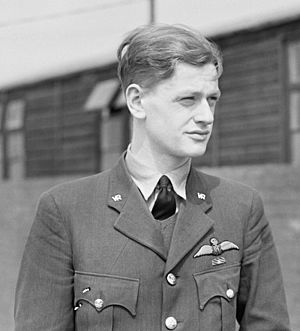Tom Neil facts for kids
Quick facts for kids
Thomas Francis Neil
|
|
|---|---|

Neil in 1941
|
|
| Nickname(s) | Ginger |
| Born | 14 July 1920 Bootle, England |
| Died | 11 July 2018 (aged 97) |
| Buried |
St Andrew's Church, Framlingham Pigot
|
| Allegiance | United Kingdom |
| Service/ |
Royal Air Force |
| Years of service | 1938–1964 |
| Rank | Wing Commander |
| Unit | No. 249 Squadron |
| Commands held | No. 41 Squadron No. 208 Squadron |
| Battles/wars | Second World War |
| Awards | Distinguished Flying Cross & Bar Air Force Cross Air Efficiency Award Bronze Star Medal (United States) Legion of Honour (France) |
Thomas Francis "Ginger" Neil (born July 14, 1920 – died July 11, 2018) was a brave British pilot. He was a fighter pilot and a "flying ace" in the Royal Air Force (RAF). During the Second World War, Neil flew in the famous Battle of Britain. He was very skilled and shot down 14 enemy aircraft.
Contents
Early Life and Dreams
Thomas Neil was born in Bootle, England, on July 14, 1920. From a young age, he loved airplanes. He also enjoyed playing sports like cricket and football for local teams.
When he was 16, his family moved to Manchester. He went to Eccles Secondary School. There, he won an art prize for a drawing of an airplane! After finishing school in 1937, he started working at a bank. At the same time, he began training to be a pilot with the Royal Air Force Volunteer Reserve (RAFVR). Neil really wanted to go to the Royal Air Force College, but his parents did not agree with his plan.
Becoming an RAF Pilot
Neil joined the RAFVR on October 17, 1938, when he was 18. When the Second World War started, he was called to serve full-time. He began his flight training on December 1, 1939. After he finished his training, he became a pilot officer.
On May 15, 1940, he joined No. 249 Squadron RAF. This was a fighter squadron that flew Hurricanes. He flew these planes from RAF North Weald during the Battle of Britain. His squadron's job was simple: shoot down as many enemy planes as possible and avoid getting shot down themselves!
During this time, he destroyed many enemy aircraft. These included six Messerschmitt Bf 109s, two Heinkel He 111s, and other types of German planes.
Battle of Britain Missions
Neil flew 141 combat missions during the Battle of Britain. He was very lucky and skilled. His only serious accident happened on November 7, 1940. He had a mid-air crash with another Hurricane. His plane lost its back section and became uncontrollable. Luckily, he managed to parachute out and landed safely with only a small leg injury.
When asked how he survived so many dangerous missions, he said he was very lucky. He also mentioned that it's important for a pilot to instinctively know what's happening around them in the sky. He was fortunate to have that special ability.
Awards and Later Service
Neil received the Distinguished Flying Cross on October 8, 1940. He received another award, a "Bar" to this medal, on November 26, 1940. These awards showed his bravery and skill in combat.
In May 1941, his squadron sailed to Gibraltar and then to Malta. They took part in the Battle of Malta. There, on June 12, 1941, he shot down an Italian Macchi C.200 fighter plane.
After leaving Malta in December 1941, Neil continued to serve in important roles. He became a tactics officer and later commanded No. 41 Squadron RAF. He also worked with the US 9th Air Force, which earned him the Bronze Star Medal from the United States. In the 1950s, he received the Air Force Cross. He retired from the RAF in 1964 as a Wing Commander.
Life After the RAF
After leaving the Royal Air Force, Neil moved to the United States. He led a British consulting company in Boston. In 1967, he returned to Great Britain and settled in Norfolk. He worked as a director in the shoe industry and later became the secretary of his local Chamber of Commerce. He retired in the early 1980s.
Thomas Neil passed away on July 11, 2018, at the age of 97.
Remembering the Battle of Britain
Neil took part in a special event for the 75th anniversary of the Battle of Britain. He flew in the largest group of Spitfires and Hurricanes seen in British skies since the Second World War. This amazing formation had 40 aircraft. They flew over southern England, where many of the air battles happened during the war. It was a great way to remember the bravery of the pilots.

